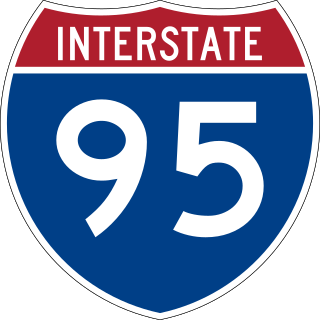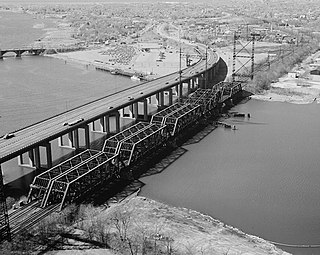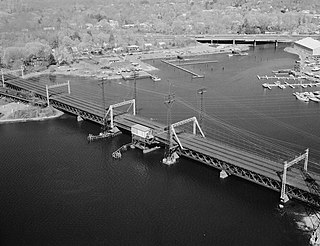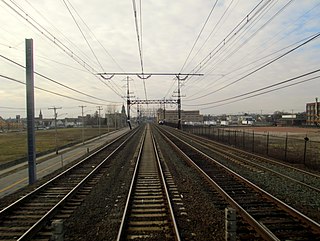
A swing bridge is a movable bridge that can be rotated horizontally around a vertical axis. It has as its primary structural support a vertical locating pin and support ring, usually at or near to its center of gravity, about which the swing span can then pivot horizontally as shown in the animated illustration to the right.

Interstate 95 (I-95) is the main north–south Interstate Highway on the East Coast of the United States, running in a general east–west compass direction for 111.57 miles (179.55 km) in Connecticut, from the New York state line to the Rhode Island state line. I-95 from Greenwich to East Lyme is part of the Connecticut Turnpike, during which it passes through the major cities of Stamford, Bridgeport, and New Haven. After leaving the turnpike in East Lyme, I-95 is known as the Jewish War Veterans Memorial Highway and passes through New London, Groton, and Mystic, before exiting the state through North Stonington at the Rhode Island border.

South Norwalk station is a commuter rail station in Norwalk, Connecticut, served by the Metro-North Railroad's New Haven Line. It is owned and managed by the Norwalk Transit District. The station is the point where the New Haven Line's Danbury Branch connects to the Northeast Corridor, as well as a peak-hour terminal for some express trains. Just east of the station are the South Norwalk Railroad Bridge and SoNo Switch Tower Museum.

The George and Cynthia Mitchell Memorial Causeway is a set of causeways in Galveston, Texas, United States. Two of the routes carry the southbound and northbound traffic of Interstate 45, while the original causeway is restricted to rail traffic. It is the main roadway access point to Galveston Island. The second access point is Bolivar Ferry.

The Portal Bridge is a two-track rotating swing-span railroad bridge over the Hackensack River in Kearny and Secaucus, New Jersey, United States. It is on the Northeast Corridor just west of Secaucus Junction and east of the Sawtooth Bridges. Owned and operated by Amtrak and used extensively by NJ Transit, it is the busiest train span in the Western Hemisphere, carrying between 150,000 and 200,000 passengers per day on approximately 450 daily trains.

Amtrak's Thames River Bridge spans the Thames River between New London and Groton, Connecticut.

The Pelham Bay Bridge, also known as the Amtrak Hutchinson River Bridge, is a two-track movable railroad bridge that carries the Northeast Corridor (NEC) over the Hutchinson River in the Bronx, New York, upstream from the vehicular/pedestrian Pelham Bridge. It is owned by Amtrak, which provides passenger service, and is used by CSX Transportation and the Providence & Worcester Railroad for freight traffic.

The Housatonic River Railroad Bridge is a historic bridge carrying Metro-North Railroad's New Haven Line trackage across the lower Housatonic River in the U.S. state of Connecticut. The bridge is also used by Amtrak for its Northeast Corridor services. It was listed on the National Register of Historic Places in 1987, which also refers to the bridge as the Devon Bridge. It is also referred to as the Devon Railroad Bridge by the state Department of Environmental Protection.

The Amtrak Old Saybrook–Old Lyme Bridge is a railroad bridge that carries the Northeast Corridor over the Connecticut River between Old Saybrook and Old Lyme, Connecticut. It is the southernmost crossing of the river before it reaches Long Island Sound. The bridge is a truss bridge with a bascule span, allowing boat traffic to pass through. The bridge is owned by Amtrak; it is used by Amtrak Northeast Regional and Acela intercity trains, Shore Line East local trains, and Providence and Worcester Railroad freight trains. A $1.3 billion replacement bridge began construction in 2024 with completion scheduled for 2031.

The Norwalk River Railroad Bridge is a swing bridge built in 1896 for the New York, New Haven and Hartford Railroad. It currently carries Amtrak and Metro-North Railroad trains over the Norwalk River.

Dock Bridge is a pair of vertical lift bridges crossing the Passaic River at Newark, Essex County and Harrison, Hudson County, New Jersey, United States, used exclusively for railroad traffic. It is the seventh crossing from the river's mouth at Newark Bay and is 5.0 miles (8.0 km) upstream from it. Also known as the Amtrak Dock Vertical Lift, it carries Amtrak, NJ Transit, and PATH trains. It is listed on the state and federal registers of historic places.

The Tomlinson Lift Bridge is a crossing of the Quinnipiac River in New Haven, Connecticut. The bridge forms a segment of U.S. Route 1. The Tomlinson Vertical Lift Bridge carries four lanes of traffic across New Haven Harbor and a single-track freight line owned by the Providence & Worcester Railroad that connects the waterfront with the Northeast Corridor line of Metro North and CSX. A sidewalk is present along the southern edge of the bridge.

The Mianus River Railroad Bridge, also known as the Cos Cob Bridge, is a bascule drawbridge built in 1904 over the Mianus River, in Greenwich, Connecticut. It was listed on the National Register of Historic Places in 1987. The bridge carries the Northeast Corridor, the busiest rail line in the United States, both in terms of ridership and service frequency. It is operated by the Metro-North Railroad, successor to Conrail, Penn Central, and the New York, New Haven and Hartford Railroad, which erected it, and is owned by the Connecticut Department of Transportation.

Niantic River Bridge, also known as Amtrak Bascule Bridge No. 116.74, is a railroad bridge carrying Amtrak's Northeast Corridor line across the Niantic River between East Lyme and Waterford, Connecticut. It is a drawbridge with a bascule-type draw span. A new bridge was constructed in 2012 to replace the former span built in 1907. It opened on September 8, 2012. Related construction work finished in June 2013.
The Congress Street Bridge was a movable deck-girder Scherzer rolling-lift bridge in Bridgeport, Connecticut, United States. In 1909, the City of Bridgeport tasked a special commission to oversee the construction of a bridge at Congress Street. The original construction was completed in 1911 for $300,000. The bridge served as a street car, vehicle and pedestrian bridge throughout its service life. In 1997, the bridge was closed after the Connecticut Department of Transportation found the substructure to be moving. The bridge was demolished in 2010 and $40 million funding for a new bridge has since been secured. The Congress Street bridge was on the Connecticut Historical Commission's list of bridges.

The East Washington Avenue Bridge refers to the bridges that have connected East Washington Avenue over the Pequonnock River in Bridgeport, Connecticut. Records state that a bridge was first constructed on the site in 1836, but no description of the bridge has been found. The second bridge was a truss swing design and underwent heavy repair and modernization in 1893. The third design was a movable Strauss underneath-counter weight deck-girder bascule bridge. The plans were drafted by James A. McElroy, using Joseph B. Strauss's design in 1916. However, construction was delayed for years because of a dispute with the contractor and a lack of funds. The bridge was completed by Bridgeport Dry Dock and Dredging when the State of Connecticut appropriated $350,000 to erect the bridge. Completed in 1925, the bridge underwent several modifications throughout its service life. On July 26, 1983, the bridge was closed after it was found to be in danger of collapse. It reopened after repair, but was closed in the 1990s before being replaced with a modern bascule bridge in 1998. In 2010, the report listed the deck and superstructure conditions as "Good" and the substructure condition as "Satisfactory".

The Grand Street Bridge was a double-leaf deck-girder bascule bridge in Bridgeport, Connecticut, United States, that spanned the Pequonnock River and connected Grand Street and Artic Street. It was one of three movable bridges planned by the City of Bridgeport in 1916 at the request of the War Department during World War I. Construction was completed in 1919, but the delays surrounding the construction went to the Connecticut Supreme Court in case of Edward DeV. Tompkins, Inc. vs. City of Bridgeport, Connecticut. The court ruled in favor of Tompkins and awarded damages equal to the contract. In 1936, the bridge had excessive settling and required the replacement of its southeast pier. As part of the repairs, a new floor and electrical system were installed. In 1965, the floor was replaced with a steel grate on I-beam floor. In 1984, the eastern approach span was replaced and the northwest trunnion post was reconstructed. The bridge was closed in the 1990s and dismantled in 1999.

Barnum station is a planned regional rail station to be located on the Metro-North Railroad's New Haven Line in East Bridgeport, Connecticut. The station will be named after the circus showman and former Bridgeport mayor P. T. Barnum, and will be located on the south side of Barnum Avenue between Seaview Avenue and Pembroke Street. A feasibility study was released in July 2013, followed by preliminary planning funding in July 2014 and an application for planning funding in June 2015. By January 2017, the station was planned to open in 2021. However, the project was indefinitely postponed in January 2019.

The Raritan River Bridge is a rail bridge over the Raritan River, in New Brunswick and Highland Park in Middlesex County, New Jersey, U.S. The arch bridge carries the Northeast Corridor (NEC) at MP 30.92. It used by Amtrak, including Northeast Regional service, and New Jersey Transit's Northeast Corridor Line. It also crosses over New Jersey Route 18.




















